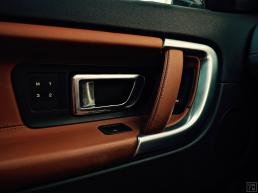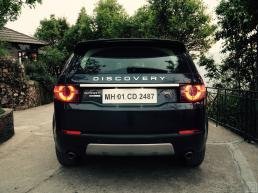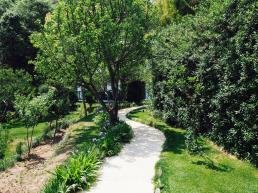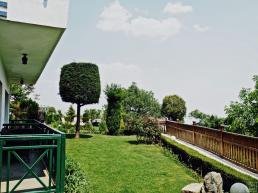It’s summer, and the hills are calling! The Land Rover Discovery Sport answers their call! We go to Kanatal and Mussoorie to explore the lower Himalayas.

We’re in the last week of April. Delhi’s simmering at 40 degrees Celsius. Real feel is closer to 45 degrees Celsius. Last week, I was in Bombay, and even though the temperature was lower, the weather was a whole lot worse. Eighty percent humidity meant there was a layer of water on your skin as soon as you got out of an air conditioned space. Seemed like a nice time to get out and head to the hills. So, that’s what we did! To make the deal sweeter, we had a Land Rover Discovery Sport to boot.
So here we are. Its eight o’ clock in the morning, and we’ve just hit NH1, moving North from Delhi towards Sonipat, Panipat and onwards to Karnal. The highway is pretty busy even at this hour. There’s quite a lot of traffic. To our advantage, it’s fast moving. Stay in the right most lane and you’ll do 70 kph consistently. The traffic is pretty well behaved too. I’d heard some not very good things about traffic in this part of the world. But so far so good.
On the highway, the Land Rover is a composed car. At 4.6m long and nearly 2.2m wide, it is rather large. Land Rover calls it a medium sized SUV, which is probably true if you park it next to the 5.2m long Range Rover LWB or the 4.8m long Range Rover Sport. Let’s not forget that the Disco Sport is actually a replacement for the Freelander, the baby Land Rover, with an all new Discovery replacement called the… uhh… Discovery, coming later this year.
Past Karnal, we get off NH1, and make our way to Yamuna Nagar, onwards to Paonta Sahib and then to Mussoorie via Dehradun. Flat-out, on a good day, one should be able to drive down from Delhi to Mussoorie via this route in just above seven hours. We took around eight, with a couple of stops on the way, and reached Mussoorie at around three in the afternoon. It’s surprisingly warm for a place located at an elevation of 2000m above sea level. But I’ve got bigger problems at the moment. You see, while in Mussoorie, we’d decided to stay at Padmini Nivas, a heritage hotel located right in the middle of Mussoorie on the Mall Road.
“
For the first time during this journey, I’m worried about the girth of this car. The road down to the hotel is just about wide enough to accommodate the Disco, and it’s steep.
“
Let’s hope no one’s coming up the same way. With some unease, we reach the hotel, park the car and settle in. Done with the drive for the day, I finally get some time to think about the way this car looks. The Disco does away with Land Rover’s boxy designs from the past generation. Even so, you know it’s a Land Rover. Ian Callum’s been working his magic again. It’s a handsome looking car, probably the best looking car in the mid-size SUV segment. The proportions are spot on. My only gripe was with the colour. I’ve seen this car in white, and I think it brings out the car’s personality in its entirety.
Talking about change. Mussoorie isn’t the same place it once used to be. Rapid commercialisation has stolen the place off its charm.It’s noisy, crowded and you’ll be hard pressed to find a clear view of the hills around without a concrete structure jutting in from somewhere.
In fact, the owner of Padmini Nivas tells me Mussoorie’s been getting warmer each passing year. All of a sudden, the lack of ceiling fans in houses in Mussoorie is turning out to be an inconvenience. The same is true of Padmini Nivas too, but one can find solace in the fact that the place has retained its old world charm. The old wing still houses functional fire places, high ceilings and old-school, teak wood furniture. The outside sitting areas are well appointed to give you a stunning view of Dehradun city down in the valley. It’s a nice place to bask in the early morning, soft sunshine and enjoy a sumptuous breakfast. That’s exactly what we did the next morning.
The rest of the day was spent driving around Mussoorie’s narrow streets. The Disco comes with Land Rover’s terrain response system as standard. Our car came kitted with the first generation of the system. The system takes a number of inputs from the vehicle’s engine, gearbox, differential and chassis systems to maximise drivability and traction. There are four standard Terrain Response settings: General Driving, Grass/Gravel/Snow, Mud & Ruts and Sand. We tested this system during our review of the Range Rover Sport a while back, and it performed up to expectations. The car also comes with Hill Descent Control, parallel and perpendicular auto parking and lots of USB ports all around the cabin to charge your mobile devices. I personally think the addition of USB ports is very thoughtful. Adapting the interior to how we live our lives these days.

On the whole, the interior is a very pleasant place to be in. The panoramic sun roof fills the cabin with light, accentuating the brown and black leather interior that our car came with. Quality levels are on par with the rest of the class, apart from a few knobs and switches here and there. The 17 speaker (Yes, Seventeen!) Meridian system cranks out tunes with aplomb and can be customised using the on screen equaliser to suit your taste. Which brings me to the In-Control suit of apps that Land Rover debuted for its vehicles last year. On paper, it seems like a great idea. Pair your phone and operate the apps via the centrally located touch screen. But app support is..uhhh.. limited, to say the least. Also, I’m not so sure it improves your experience of interacting with the car in any way whatsoever. Apart from the InControl apps section, the rest of the touch screen interface is the same as before.
It’s clunky, unintuitive and as I’ve said so many times before, a waste of centre console real estate. C’mon JLR! This area needs fixing!
It’s interesting to note here that the Disco is the only car in its segment to come with a 5+2 seating option. There’s a reason why Land Rover isn’t marketing this as a 7 seater. The third row of seats is difficult to access, and with the 2nd row pushed all the way back, can be a lil claustrophobic to sit in as well. It’s totally usable within the city. But on longer drives you’re better off carrying just 4 more people and their luggage, for which space is superb!
Once the sun started setting and the weather got cooler, I got out for a walk on Mussoorie’s Mall road, and even visited Gun Hill to hitch a ride on the ropeway. A recommendation here. The ropeway sucks. But Gun Hill isn’t so bad. It’s crowded and there’s lots of shops and restaurants, but look behind those shops and restaurants, and you get a pretty decent view of Mussoorie’s backyard. On a clear day, you’ll be able to see the snow clad mountains from here. Unfortunately, due to some man-made forest fires, clear skies were only a distant dream.
There’s a couple of restaurants diagonally across from where you disembark from the ropeway on Gun Hill, and they offer chai and snacks with a great view of the hills. It’s quite an experience. Do visit and spend some time here if you’re in Mussoorie.
Over the last few trips, I’ve given a miss to all the popular tourist destinations that a place has to offer, choosing instead to spend time roaming around in the main market place. It gives you a better sense of what the place and its people are all about. The Mall road is a busy place in the evenings, full of hustle and bustle. Vendors selling you everything, from fresh momos to lil’ trinkets that are locally produced. Do yourself a favour and avoid the momos – but take a walk along Mall Road and continue upwards on Cart Road to reach Radha Bhawan – a scenic vantage point with ruins of an old house on one side and the Dehradun valley on the other. A lil’ spooky but worth the experience.
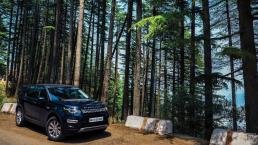
After getting a good night sleep, and after being treated to a sumptuous breakfast, we left for our next destination. Almost immediately, we had a problem. Following Google Maps, we landed up on a road that was only really suitable for two-wheelers. The next hour or so was spent swearing expletives at our beloved search provider’s maps application and very carefully navigating the streets to reach the main highway. After four near misses with the oncoming traffic, and two ‘edge of the cliff’ experiences, I decided to shift to the Disco’s in built ‘Map My India’ sourced navigation software – one that proved to be faultless throughout the remainder of the trip.
The road from Mussoorie to Kanatal (our next destination) is an absolute joy. Fifty kilometres of well surfaced tarmac with a commanding view of the Himalayas.
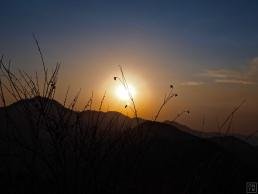
The Disco came to light on these roads, its well weighted steering and balanced handling providing me with enough confidence to push the car to the limit. No, it’s not a car to hit apexes with. But for a car that weighs over two tonnes when loaded, the Disco changes direction with surprising ease. There’s very lil’ body roll and the car inspires confidence in the person who’s driving it. What disappoints on the driving experience front, is the engine. We were driving the more powerful of the two variants on offer, the SD4 2.2L diesel producing 187 BHP, mated to a 9-speed automatic gearbox. Even in this avatar, the engine seemed to be struggling to lug around the Disco’s weight. The gearing left a lil’ to be desired as well. I found myself constantly taking over on the paddle-shifters when overtaking another car. Even on the highway, controlling the car manually provided me with a more satisfying driving experience. After driving the car around for a week, I figured that this is a software issue. The software decides what gear to choose based on a number of different variables, one of them being your throttle input. What I realised was that a normal throttle progression to accelerate the car brought about a sudden downshift around 1800RPM, boosting the RPM to around 2400RPM and providing a slight jerk inside the cabin. It could very well be a case of the car not suiting my driving style, but this is not a problem I’ve faced with any of the three German manufacturers’ cars. I’m not so sure Land Rover can do much about this at this point of time. But subsequent versions of the car (next model year maybe) should come with a software tweak.

It’s a different story that subsequent versions of the car might not need this software tweak at all. That’s because they’ll most likely come with JLR’s brand new Ingenium series of engines, which are lighter, offer lower emissions and better drivability off the assembly line. In all probability, these engines should be hitting our shores by the end of this year. They offer a big step forward from the current crop of engines.
Moving on. Two hours into a very satisfying drive, we reached our destination. Kanatal, located 50km away from Mussoorie, is higher, prettier and more secluded. Twenty-Six hundred metres above sea level, Kanatal lies in the Garhwal Tehri region of Uttarakhand. The place is dotted with a few hotels and campsites here and there, but that’s about it. We booked our stay in a niche, boutique hotel called “The Terraces”. Named after the way the hotel is laid out on the terraces perched on the hills, this boutique hotel offers unobstructed views of the lower Himalayas from each room. It also features beautifully manicured lawns, well-kept flower patches and a tastefully designed Machan and evening tea area, complete with hammocks and Khatiyas (wooden and jute cots).
Built piece by piece over the last 12 years, the hotel has 21 well-appointed rooms spread out across the property, a spa, a yoga room, a mini-gymnasium, a children’s play area and a restaurant that serves delicious food. It has a wonderful vibe, this place. Every little detail feels like it’s been given some thought. You get this feeling someone put their heart and soul into this pace, and it shows.

“
One of these evenings, the manager arranged for a short trek for me to go and photograph the area. I must’ve walked around a kilometre, and I reached the top of the hill from where I got a 360 degree panoramic view of the hills. With the sun setting, I quickly took a few shots, the wind crashing against my face, and getting cooler each minute.
“
Far in the distance, I could see a couple of forest fires burning. My guide tells me of how carelessness and a casual attitude towards protecting the flora and fauna results in forest fires every year. The hotel has started a full blown campaign in association with the forest department, and hopes to spread awareness on the dangers of forest fires.
Kanatal is a rather quaint place. A book kept at the hotel reception, and written by Ruskin Bond talks about how the women in this area seem to get all the work done, while the men laze around, pretending to play a big part in sheep grazing. Can’t be that difficult right? Show a sheep some grass, and it should graze by itself. It’s that kind of a town, though. Small, laid-back, spectacular!
During our stay there, we managed to take some time off relaxing and drove down to the Tehri dam. What an imposing structure! It takes you by surprise by its mere size. It’s 260m high, 1.1km wide at its base and 600m in length. Ha! And you thought the Disco Sport was large! Guess “medium size” does fit the Disco’s stature.

On our final day, we headed for Delhi via Rishikesh. This time around we took the route via Muzzafarnagar and Meerut. All those things I told you about the traffic in this area not being well behaved? It all sort of made sense now. The route to Mussoorie/ Kanatal/ Dehradun via Karnal (NH1) is around 50km longer, but ends up taking the same amount of time as the route via Meerut. If you’re heading this way, I’d suggest you take the route via Karnal. It’s a better drive.
All in all, the round trip lasted roughly 6 days. Twelve Hundred kilometres covered in the Disco Sport. I can say with confidence that this is one of the best cars in its segment. It looks better than the rest, it’s more comfortable, it drives as well as the competition and come year end, it’ll have the powertrain to rule over them!



